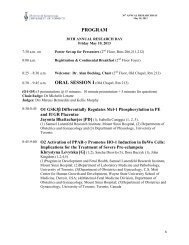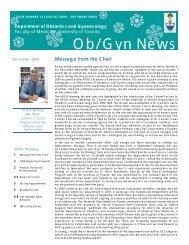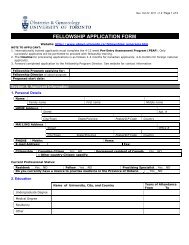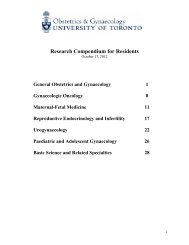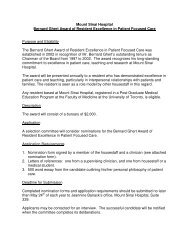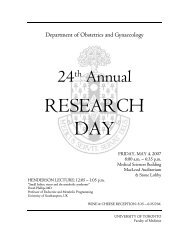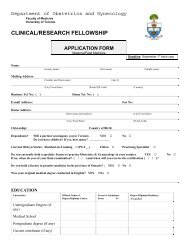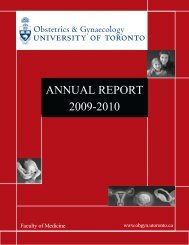research day - University of Toronto Department of Obstetrics and ...
research day - University of Toronto Department of Obstetrics and ...
research day - University of Toronto Department of Obstetrics and ...
You also want an ePaper? Increase the reach of your titles
YUMPU automatically turns print PDFs into web optimized ePapers that Google loves.
51<br />
ABSTRACT #P-C1<br />
EARLY TRANSVAGINAL ULTRASOUND AT 13-15 WEEKS IS HIGHLY EFFECTIVE<br />
IN DETECTION OF FETAL ANOMALIES.<br />
Erika Frasca [M](1), Ants Toi (2), David Chitayat (3), Dan Farine (4), Karen Chong (3), Katherine<br />
Fong K. (2), Ori Nevo (5). (1) Faculty <strong>of</strong> Medicine, <strong>University</strong> <strong>of</strong> <strong>Toronto</strong>, (2) <strong>Department</strong> <strong>of</strong> Medical<br />
Imaging, Mount Sinai Hospital, (3) Prenatal Diagnosis <strong>and</strong> Medical Genetics Program, Mount Sinai<br />
Hospital (4) Maternal Fetal Medicine, <strong>Department</strong> <strong>of</strong> <strong>Obstetrics</strong> <strong>and</strong> Gynaecology, Mount Sinai Hospital, 5)<br />
Maternal-Fetal Medicine, <strong>Department</strong> <strong>of</strong> <strong>Obstetrics</strong> <strong>and</strong> Gynaecology, Sunnybrook Health Sciences Centre.<br />
<strong>University</strong> <strong>of</strong> <strong>Toronto</strong>.<br />
Objectives: Transabdominal fetal ultrasound at 19-21 weeks is currently the most accepted<br />
practice for fetal anomaly detection, even in women at high risk for having a baby with major<br />
anomalies. However, earlier detection <strong>of</strong> fetal anomalies may enable sufficient time for further<br />
tests <strong>and</strong> safer management. The objective <strong>of</strong> this study was to compare the detection rate <strong>of</strong> fetal<br />
anomalies <strong>and</strong> completeness <strong>of</strong> transvaginal early anatomy ultrasound (TEAU) at 13-15 weeks to<br />
the st<strong>and</strong>ard 19-21 week transabdominal ultrasound (TAS).<br />
Methods: Data from women who had a TEAU at Sunnybrook Health Sciences Centre at 13-15<br />
weeks between April 2007 <strong>and</strong> August 2008 was collected. TEAU included detailed fetal anatomy<br />
examination comparable to the st<strong>and</strong>ard ultrasound at 19-21 weeks. Women with higher risk for<br />
fetal anomalies due to an elevated nuchal translucency, previous fetal anomalies, maternal<br />
conditions or other risk factors, <strong>and</strong> obese women (BMI ≥ 30 kg/m 2 ) were included. St<strong>and</strong>ard TAS<br />
was performed at 19-21 weeks. TEAU was performed by a single highly skilled physician, <strong>and</strong><br />
TAS was performed by qualified technologists in a university facility. Detection rate <strong>of</strong> fetal<br />
anomalies <strong>and</strong> complete ability to assess the various fetal organs during the scan were compared<br />
between the TEAU <strong>and</strong> the st<strong>and</strong>ard TAS, <strong>and</strong> to the outcome at delivery.<br />
Results: 156 women were included with a mean maternal age <strong>of</strong> 33.2±4.5 years. The indications<br />
for a TEAU were an elevated nuchal translucency (25%), fetal anomaly in previous pregnancy<br />
(44%), maternal conditions (18%) <strong>and</strong> other risk factors (12%). 17% <strong>of</strong> the women were obese.<br />
TEAU was performed at a mean gestational age <strong>of</strong> 14.8±0.8 weeks <strong>and</strong> TAS was performed at a<br />
mean gestational age <strong>of</strong> 19.3±0.8 weeks. A total <strong>of</strong> 27 fetal abnormalities were observed, 23 <strong>of</strong><br />
which had ultrasonographically detectable anomalies. There was no significant difference in the<br />
anomaly detection rate between TEAU versus a later TAS. TEAU detected 22/23 (95.6%)<br />
anomalies; one undetected abnormality was a late onset skeletal dysplasia. 16 pregnancies were<br />
terminated before the second scan. All abnormalities (100%) were detected in fetuses <strong>of</strong> women<br />
who completed a TAS. Increased BMI was associated with more complete images using TEAU<br />
(73% vs. 59%). 9/39 (23%) fetuses with elevated nuchal translucency had fetal anomalies that were<br />
detected by TEAU <strong>and</strong> 3 additional fetuses had anomalies that were not ultrasonographically<br />
detectable. At the time <strong>of</strong> the TEAU, s<strong>of</strong>t markers for Down syndrome (elevated nuchal<br />
translucency, echogenic bowel, pleural effusion) were detected in 39 women. In 23 cases, the s<strong>of</strong>t<br />
markers were not seen at the TAS. 20/23 had normal outcomes, while 3 had abnormal outcomes.<br />
Conclusions: Early transvaginal ultrasound performed at 13-15 weeks is highly effective in<br />
detecting fetal anomalies <strong>and</strong> is comparable to the st<strong>and</strong>ard ultrasound at 19-21 weeks.<br />
Additionally, TEAU improves the completeness <strong>of</strong> scans in obese women compared to the<br />
st<strong>and</strong>ard ultrasound. TEAU has an important role in the management <strong>of</strong> women with high risk for<br />
fetal anomalies <strong>and</strong> in obese women <strong>and</strong> should be <strong>of</strong>fered to patients.



